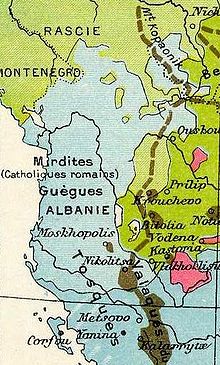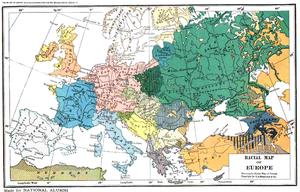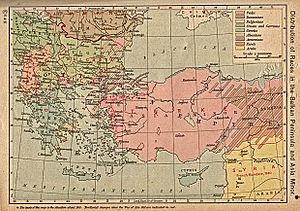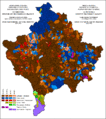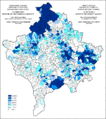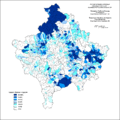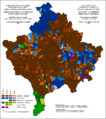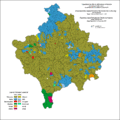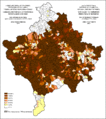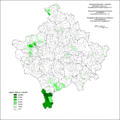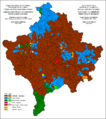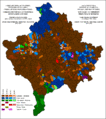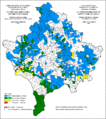- Demographics of Kosovo
-
The demographic features of the population of Kosovo, includes various factors such as population density, ethnicity, education level, health of the populace, economic status, religious affiliations and other aspects of the population.
Kosovo has an estimated population of 1,733,872 (as of 2011 Census, which was boycotted by Kosovo Serbs).[1] The dominant ethnic group is Albanian, with significant minorities of Serbs (a constituent nation) and others.
Population
The 2000 Living Standard Measurement Survey by Statistical Office of Kosovo (rejected by Belgrade[2]): Total population estimated between 1.8-2.0 million.[3] From 2000, AMSJ (confirmed by Kosovo Statistical Office in 2003), estimating a 1,900,000 strong population.
Kosovo currently has the youngest population in Europe, with a fertility estimated by the Census Bureau of 2.4 children per woman. [3] As recently as 1990, [4] Kosovo's population structure resembled those of countries like Haiti, and was in stark contrast to the rest of Serbia [5] and other European countries. In recent years, however, Kosovo's population growth rate has begun to slow and its birth rate has decreased.
Vital statistics[4]
Population estimates in the table below may be unreliable since the 1990s. Besides, births and deaths exclude territories with a Serbian majority.
Average population (x 1000) Live births Deaths Natural change Crude birth rate (per 1000) Crude death rate (per 1000) Natural change (per 1000) 1948 733 27 792 10 324 17 468 37.9 14.1 23.8 1949 751 31 643 12 937 18 706 42.1 17.2 24.9 1950 764 35 222 12 991 22 231 46.1 17.0 29.1 1951 780 29 299 14 833 14 466 37.6 19.0 18.5 1952 793 35 619 13 867 21 752 44.9 17.5 27.4 1953 813 34 595 16 726 17 869 42.6 20.6 22.0 1954 832 38 595 13 201 25 394 46.4 15.9 30.5 1955 842 36 736 15 292 21 444 43.6 18.2 25.5 1956 859 37 819 13 692 24 127 44.0 15.9 28.1 1957 873 34 159 15 300 18 859 39.1 17.5 21.6 1958 890 39 285 11 598 27 687 44.1 13.0 31.1 1959 921 37 364 12 878 24 486 40.6 14.0 26.6 1960 944 41 631 13 365 28 266 44.1 14.2 29.9 1961 972 40 561 11 759 28 802 41.7 12.1 29.6 1962 997 41 336 15 024 26 312 41.5 15.1 26.4 1963 1 021 41 525 12 423 29 102 40.7 12.2 28.5 1964 1 046 42 557 12 731 29 826 40.7 12.2 28.5 1965 1 075 43 569 11 767 31 802 40.5 10.9 29.6 1966 1 101 42 429 10 266 32 163 38.5 9.3 29.2 1967 1 131 44 001 11 308 32 693 38.9 10.0 28.9 1968 1 159 44 627 10 781 33 846 38.5 9.3 29.2 1969 1 189 46 480 10 892 35 588 39.1 9.2 29.9 1970 1 220 44 496 10 829 33 667 36.5 8.9 27.6 1971 1 254 47 060 10 312 36 748 37.5 8.2 29.3 1972 1 291 47 943 10 270 37 673 37.1 8.0 29.2 1973 1 329 47 714 10 358 37 356 35.9 7.8 28.1 1974 1 367 49 847 10 075 39 772 36.5 7.4 29.1 1975 1 406 49 310 10 018 39 292 35.1 7.1 27.9 1976 1 446 51 355 10 149 41 206 35.5 7.0 28.5 1977 1 487 49 849 9 811 40 038 33.5 6.6 26.9 1978 1 526 49 027 9 776 39 251 32.1 6.4 25.7 1979 1 566 48 125 9 575 38 550 30.7 6.1 24.6 1980 1 555 53 147 8 909 44 238 34.2 5.7 28.4 1981 1 595 48 111 9 677 38 434 30.2 6.1 24.1 1982 1 629 52 865 10 479 42 386 32.5 6.4 26.0 1983 1 664 49 645 11 040 38 605 29.8 6.6 23.2 1984 1 699 55 243 10 573 44 670 32.5 6.2 26.3 1985 1 735 53 925 11 826 42 099 31.1 6.8 24.3 1986 1 773 54 519 10 446 44 073 30.7 5.9 24.9 1987 1 811 56 221 10 307 45 914 31.0 5.7 25.4 1988 1 850 56 283 10 257 46 026 30.4 5.5 24.9 1989 1 889 53 656 10 181 43 475 28.4 5.4 23.0 1990 1 930 55 175 8 214 46 961 28.6 4.3 24.3 1991 1 967 52 263 8 526 43 737 26.6 4.3 22.2 1992 2 006 44 418 8 004 36 414 22.1 4.0 18.2 1993 2 043 44 132 7 804 36 328 21.6 3.8 17.8 1994 2 077 43 450 7 667 35 783 20.9 3.7 17.2 1995 2 113 44 776 8 671 36 105 21.2 4.1 17.1 1996 2 151 46 041 8 392 37 649 21.4 3.9 17.5 1997 2 186 42 920 8 624 34 296 19.6 3.9 15.7 1998 2 000 41 752 8 123 33 629 20.9 4.1 16.8 1999 2 000 40 020 7 569 32 451 20.0 3.8 16.2 2000 2 000 38 667 7 115 31 552 19.3 3.6 15.8 2001 2 000 37 412 6 672 30 740 18.7 3.3 15.4 2002 1 985 36 136 5 654 30 482 18.2 2.8 15.4 2003 2 016 31 994 6 417 25 577 15.9 3.2 12.7 2004 2 041 35 063 6 399 28 664 17.2 3.1 14.0 2005 2 070 37 218 7 207 30 011 18.0 3.5 14.5 2006 2 100 34 187 7 479 26 708 16.3 3.6 12.7 2007 2 126 33 112 6 681 26 431 15.6 3.1 12.4 2008 2 153 34 399 6 852 27 547 16.0 3.2 12.8 2009 2 175 34 240 7 030 27 210 15.7 3.2 12.5 2010 Ethnic groups
Further information: Albanians of Kosovo, Serbs of Kosovo, Montenegrins of Kosovo, Roma of Kosovo, Gorani (ethnic group), Turks in Kosovo, and JanjevciThe official results of the censuses in Kosovo as part of Yugoslavia after World war II are tabulated below. The proportion of Albanians was below 70% until 1961, but increased to 81.6% in 1991.
Population of Kosovo according to ethnic group 1948-1991 Ethnic
groupcensus 1948 census 1953 census 1961 census 1971 census 1981 census 1991 Number % Number % Number % Number % Number % Number % Albanians 498,244 68.5 524,559 64.9 646,605 67.1 916,168 73.7 1,226,736 77.4 1,596,072 81.6 Serbs 171,911 23.6 189,869 23.5 227,016 23.5 228,264 18.4 209,498 13.2 194,190 9.9 Muslims 9,679 1.3 6,241 0.8 8,026 0.8 26,357 2.1 58,562 3.7 Montenegrins 28,050 3.9 31,343 3.9 37,588 3.9 31,555 2.5 27,028 1.7 Croats 5,290 0.7 6,201 0.8 7,251 0.8 8,264 0.7 8,718 0.6 Yugoslavs 5,206 0.5 920 0.1 2,676 0.2 Romani 11,230 1.5 11,904 1.5 3,202 0.3 14,593 1.2 34,126 2.2 45,745 2.3 Turks 1,315 0.2 34,583 4.3 25,764 2.7 12,244 1.0 12,513 0.8 10,445 0.5 Macedonians 526 0.1 972 0.1 1,142 0.1 1,048 0.1 1,056 0.1 Others or unspecified 1,577 0.2 2,469 0.3 2,188 0.2 4,280 0.3 3,454 0.2 109,744 5.6 Total 727,820 808,141 963,988 1,243,693 1,584,441 1,956,196 The 2000 Living Standard Measurement Survey by Statistical Office of Kosovo found an ethnic composition of the population as follows:
- 92% Albanians
- 8% others
A most comprehensive (October 2002) estimate (for the 1.9 million inhabitants) for these years:
During the Kosovo War in 1999, over 700,000 ethnic Albanians[5] and around 100,000 ethnic Serbs were forced out of the province to neighbouring Albania, Macedonia, Montenegro, Bosnia and Serbia. After the United Nations took over administration of Kosovo following the war, the vast majority of the Albanian refugees returned.[citation needed] The largest diaspora communities of Kosovo Albanians are in Germany and Switzerland accounting for some 200,000 individuals each, or for 20% of the population resident in Kosovo.
Many non-Albanians - chiefly Serbs and Roma - fled or were expelled, mostly to the rest of Serbia at the end of the war, with further refugee outflows occurring as the result of sporadic ethnic violence. The number of registered refugees is around 250,000.[6][7][8] The non-Albanian population in Kosovo is now about half of its pre-war total[citation needed]. The largest concentration of Serbs in the province is in the north, but many remain in Kosovo Serb enclaves surrounded by Albanian-populated areas. Also, according to Serbian sources, the Gorani people, living on the south-most tip of the Kosovo are systematically oppressed and denied their minority rights.[9]
Religion
Muslims are over 90% of the population (1,800,000) (mostly Sunni, with a small Sufi minority), Orthodox Christians 6% and Roman Catholics are 3% and close to 1% Protestant. Islam is the predominant religion professed by the ethnic Albanian population of Kosovo, the Bosniak, Gorani and Turkish communities, and some of the Roma/Ashkali/Egyptian community.[10] Protestant Community in Kosovo started in 1870-ties, and today in country are more than 28 Protestant Evangelical Churches.
During the 2000s, large investments in Kosovo were made by Middle Eastern charities, especially Saudi Arabian. The new Hasan Beg mosque in Pristina is entirely Saudi-financed. There are concerns that these investments are made with the intention of fostering radical Islam in Kosovo.[11]
The Serb population, estimated at 100,000 to 150,000 persons, is largely Serbian Orthodox. The Catholic Albanian communities are mostly concentrated in Đakovica, Prizren and Peć and few villages near Uroševac and Klina who have 3% of population in Kosovo.[citation needed].
History
Archeological findings show that Bronze and Iron Age tombs were found only in Metohija, not in Kosovo proper.[12]
The region was inhabited by Illyrians, Celts[13][14] and Thracians.[14][15] After Roman conquest of Illyria at 168 BC, Romans colonized and founded several cities in the region.[16]
Slavs are mentioned in the area since the 520s AD, with the Slav tribe of Sklavenoi settling the Praetorian prefecture of Illyricum, the mythological founders of the Serbs were the White Serbs; "who settled in the Balkans during the rule of Emperor Heraclius" (610-641).[17] In the 12th century, according to the Byzantine Empress Anna Angelina Komnenos, the Serbs were the main inhabitants of Kosovo (Eastern Dalmatia and former Moesia Superior).[18] Archeological findings from the 7th century onwards show a Serb (Slavic) cultural domination in case of glagolithic letters, pottery, cemeteries, churches and monasteries.[19][verification needed]
In 1054 the Great Schism occurred in the realm, the Byzantine Empire (Roman) was divided on religious basis and Kosovo & Metohija was part of the Orthodox world (Subsequently the base of the Serbian Orthodox Church). Catholicism did not exist in the native population.
14th century
1321-1331
The Dečani charters (Serbian: Дечанске хрисовуље) from 1321-1331 by Stephen Uroš III Dečanski of Serbia contains a detailed list of households and villages in Metohija and northwestern Albania. The first charter concludes that this region was ethnically Serb.[20]
89 settlements with 2,666 households were recorded of which:[21]
- 86 Serbian settlements (96,6%)
- 3 Albanian settlements (3,3%)
2,166 livestock households of 2,666 agricultural households:
- 2,122 Serbian households (98%)
- 44 Albanian households (2%)
15th century
The ethnic composition of Kosovo's population during this period included Serbs, Albanians, and Vlachs along with a token number of Greeks, Armenians, Saxons, and Bulgarians, according to Serbian monastic charters or chrysobulls (Hrisovulja). A majority of the given names in the charters are overwhelmingly Serbian (Of 24,795 names, 23,774 were ethnic Serb names, 470 of Roman origin, 65 of Albanian origin and 61 of Greek origin).
Researches of the early Turkish cadastre (Defter) is often interpreted in two ways. Serbian scholars draw the conclusion that Serbs were majority until the 17th century. Alain Ducellier claims that the population of Kosovo in the 14th and 15th centuries was in fact "still Albanian and Christian."[22]
1455
1455: Turkish cadastral tax census (defter)[23] of the Brankovic dynasty lands (covering most of present-day Kosovo) recorded:
- 480 villages,
- 13,693 adult males,
- 12,985 dwellings,
- 14,087 household heads (480 widows and 13,607 adult males).
Totally there were around 75,000 inhabitants in 590 villages comprising modern-day Kosovo.
Turkish defter did not give any data on ethnicity. However, Yugoslav and Serbian sholars have researched ethnic structure of Kosovo population. According to them there were[24]:
- 13,000 Serb dwellings present in all 480 villages and towns
- 75 Vlach dwellings in 34 villages
- 46 Albanian dwellings in 23 villages
- 17 Bulgarian dwellings in 10 villages
- 5 Greek dwellings in Lauša, Vučitrn
- 1 Jewish dwelling in Vučitrn
- 1 Croat dwelling
1487
1487: A census of the House of Branković[citation needed]
- Vučitrn district:
- Ipek (Peć) district:
-
- City of Ipek
- 121 Christian household
- 33 Muslim households
- Suho Grlo and Metohija:
-
- 131 Christian household of which 52% in Suho Grlo were Serbs
- Donja Klina - 50% Serbs
- Dečani - 64% Serbs
- Rural areas:
-
- 6,124 Christian housings (99%)
- 55 Moslem houses (1%)
16th century
1520-1535
- Vučitrn: 19,614 households
- Christians
- 700 Muslim households (3,5%)
- Prizren
- Christians
- 359 Muslim households (2%)
1582
1582: Ottoman defter census (Tahrir defterleri)[25]
- Peć nahiya:
-
- 235 villages of which some 30 have Albanian families besides the majorital Orthodox Serbs.
-
- City of Peć - 18 mahalas; 3 free, 13 Muslim (newly Islamicised), 5 Serbian (2 houses were Albanian)
- Village Osek - Muslim (Islamicised) majority, with some settled Christian Albanians
- Village Selojani - Muslim majority, small Christian Albanian and Serb population
- Village Mramor - 22 houses. Albanian majority
- Village Belovci - 50 Serbian houses.
- Village Granica - 65 Serbian houses.
- Village Belo Polje[disambiguation needed
 ] - 2 Serbian mahalas. 3 priests.
] - 2 Serbian mahalas. 3 priests. - Village Bukovica - Serbian. 2 converts to Islam.
- Village Lipovac - Islamicised Albanian.
- Village Trakakin - Albanian. Islamicised majority.
- Village Baba - Serbian. 1 convert to Islam.
- Village Videš - Serbian.
- Village Veliki Đurđevik - 64 Serbian houses. 2 families from Prizren and Vučitrn.
- 17 Serb villages: 1 Albanian house.
- Village Suho Grlo - 3 Serbian mahalas. 1 Islamicised Serb.
- 3 Serb villages
- 17 Serb villages: 3 Muslim houses. 8 priests.
- Village Zlokućani - Serbian. 5 Muslim houses.
- Village Kavlica - Serbian. 8 Muslim houses.
- Village Strelice - 70 Serbian houses. few Islamicised.
- 8 Serb villages
- Village Rusance - Albanian majority. 3 Muslims.
- Village Muževine - Serbian. 1 priest.
- Village Srednja Crnja - 8 Albanian Muslim houses.
- 34 Serb villages: total 2 Albanian houses in 2 villages.
- Village Njivokos - Serbian majority. Notable Islamicisation.
- Village Vrela Manastir - Serbian.
- 13 Serb villages: 1 Islamicised house.
- Village Gusnica - 20 Albanian Islamicised houses.
- 15 Serb villages: Islamicisation occurred in 3 villages.
- Village Vinodol - Serbian. 8 soldier houses from Bosnian Sandzak.
- Village (?) - Serbs, Albanians and Muslims.
- 20 Serb villages: occurrence of Islamicisation.
- 2 Albanian villages: Islamicised.
- 39 Serb villages: 9 monasteries (one is Dečani). 1 Albanian male.
- Village Brestovac - 10 Albanian houses.
- Village Belica - 35 Muslim houses.
- 56 villages: 42 Serb villages of which 14 with a Muslim minority.
- Village Novosel - Muslim and Albanian.
- Village Labranima - Serbian majority. 2 Muslim houses.
- Village Dubak - 10 Albanian houses and 9 Muslim houses.
- Village Dobroševo - 28 houses. Albanian majority. 3 Muslim houses.
- Village Šankovac - Serbian majority. 3 Muslim houses.
- Village Dobrič-Dol - Muslim.
- Village Gornji Petrič - Serbian majority. ~50 Serbian houses, 3 Muslim houses.
- Village Vranić - Muslim and Albanian.
- Village Crni Potok - 25 Muslim houses.
- Village Arženik - Serbian. Few Muslim houses.
- Village Prelopci - Serbs, Albanians and Muslims.
- Village Rugovo - 86 Serbian houses.
- Altun-li nahiya:
-
- 41 villages - Serb majority, Albanian minority.
1591
Ottoman defter from 1591[26]:
17th - 18th centuries
The Great Turkish War of 1683–1699 between the Ottomans and the Habsburgs led to the flight of a substantial part of Serbian population to Austrian held Vojvodina and the Military Frontier - about 37,000 families of Serb refugees were led by Patriarch Arsenije III Crnojević settled in the Habsburg Monarchy, mostly from today's Kosovo - this being known as the Great Migration of Serbs. And then again, from the period between 1717 and 1737, the Second Migration of Serbs.
19th century
19th century data about the population of Kosovo tend to be rather conflicting, giving sometimes numerical superiority to the Serbs and sometimes to the Albanians. The Ottoman statistics are regarded as unreliable, as the empire counted its citizens by religion rather than nationality, using birth records rather than surveys of individuals.
A study in 1838 by an Austrian physician, dr. Joseph Müller found Metohija to be mostly Slavic (Serbian) in character.[27] Müller gives data for the three counties (Bezirke) of Prizren, Peć and Đakovica which roughly covered Dukagjini, the portion adjacent to Albania and most affected by Albanian settlers. Out of 195,000 inhabitants in Dukagjini, Müller found:
- 114,000 Muslims (58%):
- Christians:
- 2,308 other non-Muslims (Janjevci etc.)
Müller's observations on towns:
- Peć: 11,050 Serbs, 500 Albanians
- Prizren: 16,800 Serbs, 6150 Albanians
- Đakovica: majority of Albanians, surrounding villages Serbian
Map published by French ethnographer G. Lejean[28] in 1861 shows that Albanians lived on around 57% of the territory of today's province while a similar map, published by British travellers G. M. Mackenzie and A. P. Irby[28] in 1867 shows slightly less; these maps don't show which population was larger overall. Nevethless, maps cannot be used to measure population as they leave out density.
A study done in 1871 by Austrian colonel Peter Kukulj[29] for the internal use of the Austro-Hungarian army showed that the mutesarifluk of Prizren (corresponding largely to present-day Kosovo) had some 500,000 inhabitants, of which:
- 318,000 Serbs (64%),
- 161,000 Albanians (32%),
- 10,000 Roma (Gypsies) and Circassians
- 2,000 Turks
Modern Serbian sources estimated that around 400,000[30] Serbs were cleansed out of the Vilayet of Kosovo between 1876 and 1912, especially during the Greek-Ottoman War in 1897.[31]
Maps published by German historian Kiepert[28] in 1876, J. Hahn[28] and Austrian consul K. Sax,[28] show that Albanians live on most of the territory of today's province, however they don't show which population is larger. According to these, the regions of Kosovska Mitrovica and Kosovo Polje were settled mostly by Serbs, whereas most of the terrirory of western and eastern parts of today's province was settled by Muslim Albanians.
An Austrian statistics[32] published in 1899 estimated:
At the end of the 19th century, Spiridon Gopchevich, an Austrian traveller - comprised a statistics and published them in Vienna. They established that Prizren had 60,000 citizens of whome 11,000 were Christian Serbs and 36,000 Moslem Serbs. The remaining population were Turks, Albanians, Tzintzars and Roma. For Pec he said that it had 2,530 households of which 1,600 were Mohammedan, 700 Christian Serb, 200 Catholic Albanian and 10 Turkish.
Note: Descendants of Muslim Serbs mentioned by travelers today mostly self-declare as Muslims by nationality, Bosniaks or Gorani. Also note that territory of Ottoman Kosovo Vilayet was quite different than modern-day Kosovo.
20th century
British journalist H. Brailsford estimated in 1906[33] that two-thirds of the population of Kosovo was Albanian and one-third Serbian. The most populous western districts of Đakovica and Peć were said to have between 20,000 and 25,000 Albanian households, as against some 5,000 Serbian ones. A map of Alfred Stead,[34] published in 1909 , shows that similar numbers of Serbs and Albanians were living in the territory.
German scholar Gustav Weigand gave the following statistical data about the population of Kosovo,[35] based on the pre-war situation in Kosovo in 1912:
- Pristina District: 67% Albanians, 30% Serbs
- Prizren District: 63% Albanians, 36% Serbs
- Vučitrn District: 90% Albanians, 10% Serbs
- Uroševac District: 70% Albanians, 30% Serbs
- Gnjilane District: 75% Albanians, 23% Serbs
- Mitrovica District: 60% Serbs, 40% Albanians
Metohija with the town of Đakovica is furthermore defined as almost exclusively Albanian by Weigand.[35] Citing Serbian sources, Noel Malcolm also states that in 1912 when Kosovo came under Serbian control, "the Orthodox Serb population at less than 25%,[6]"
Balkan Wars and World War I-World War II
- The 1921 Kingdom of Serbs, Croats and Slovenes population census for the territories comprising modern day Kosovo listed 439,010 inhabitants:
- By religion:
- Muslims: 329,502 (75%)
- Orthodox Serb: 93,203
- Roman Catholics: 15,785
- Jews: 427
- Greek Catholics: 26
- By native language:
- Albanian: 288,907 (65.8%)
- Serbian or Croatian: 114,095 (26.0%)
- Turkish: 27,915 (6.4%)
- Romanian-Cincarian: 402
- Slovene: 184
- German: 30
- Hungarian: 12
- According to the 1931 Kingdom of Yugoslavia population census, there were 552,064 inhabitants in today's Kosovo.
- By religion:
- Muslims: 379,981 (68.83%)
- Orthodox Serbs: 150,745 (27.31%)
- Roman Catholics: 20,568 (3.73%)
- Evangelists: 114 (0.02%)
- other: 656 (0.12%)
- By native language:
The colonisation of Kosovo began during the Balkan Wars.[36] After the World War I began systematic colonization as a state project of Yugoslavian Kingdom. The table shows total number of registered settlers in each Kosovo area[37]:
COLONISATION OF KOSOVO Regional Center Number of Colonists Uroševac 15.381 Đakovica 15.824 Prizren 3.084 Peć 13.376 Mitrovica 429 Vučitrn 10.169 Total 58.263 The process was a result of the agrarian reform pursued by the Yugoslavian authorities. "Tax and property incentives for Serbs to move to Kosovo produced a measurable demographic change in Kosovo’s cities by 1929, but the province’s overall ethnic balance remained roughly 60% Albanian, 35% Serb,[7]".
The ethnic Albanian and Turkish population, at the time, in Kosovo and Metohia were reluctant to reconcile with living in a European-organized state where, instead of the status of the absolutely privileged class they had enjoyed during the Turkish rule, they acquired only civil equality with what had previously been the infidel masses. Discontent with the new state among the ethnic Albanian masses stepped up emigration to Turkey, in whose Muslim environment they felt at home.[38]
By the 1930s, thousands of ethnic Albanian and Turkish families were forcefully deported[39] to Turkey Republic of Turkey, and in 1938, after lengthly negotiations, the Yugoslav and Turkish governments prepared a convention on the emigration of some 200,000 Muslims (ethnic Albanians and Turks) from Kosovo-Metohia and Macedonia to Turkey. Because the Turkish government abandoned the agreement and a lack of funds to dispatch the emigrants, the convention was never implemented. The Yugoslav authorities conducted a census on the region of Kosovo in 1939. The census was handed poorly and not finished. It registered some 125,000 Albanians, while the number of the entire non-Slav population (Albanians, Turks, Roma etc.) was 422,828 or 65.6%. The percentage of native Slavic population and the colonists was 25.2% and 9.2%, respectively.[38]
It was followed by a mass exodus of tens of thousands of Serbs during the Second World War. After the war, liberal Yugoslav policies allowed the Albanian population to increase from 75% to well over 90% through increased birth rate and immigration, in contrast, the Serbian population waned to just 8% of the pre war population. During the Kosovo War, roughly a half of Albanians and Serbians left Kosovo.[40]
World War II
Most of the territory of today's province is occupied by Italian-controlled Greater Albania, massacres of some 10,000[41][42] Serbs, ethnic cleansing of about 100[41] to 250,000[41][43] or more[42]
Nazi Germany estimated that from November 1943 to February 1944, 40 000 Serbs fled Italian-occupied Kosovo for Montenegro and Serbia.
 On graph are displayed percentages of Albanian and Serbian population in Kosovo during 20th century[citation needed]. All other nations together never took more than 6%, so they are not displayed
On graph are displayed percentages of Albanian and Serbian population in Kosovo during 20th century[citation needed]. All other nations together never took more than 6%, so they are not displayed
1948 census
727,820 total inhabitants:
- 498,242 Albanians (68.46%)
- 171,911 Serbs (23.62%)
- 28,050 Montenegrins (3.86%)
- 11,230 Roma (1.54%)
- 5,290 Croats (0.73%)
- 1,315 Turks (0.18%)
- 526 Macedonians (0.07%)
- 362 Russians (0.05%)
- 283 Slovenes (0.04%)
- 197 Germans (0.03%)
- 83 Hungarians (0.01%)
- 77 Bulgarians (0.01%)
- 39 Italians
- 31 Rusyns
- 29 Czechs
- 18 Romanians
- 2 Slovaks
- 9,679 undecided Muslims (1.33%)
- 456 other and unknown (0.06%)
1953 census
808,141 total inhabitants
- 524,559 Albanians (64.91%)
- 189,969 Serbs (23.51%)
- 34,583 Turks (4.28%)
- 31,343 Montenegrins (3.88%)
- 6,201 Croat (0.77%)
- 972 Macedonians (0.12%)
- 411 Slovenes (0.05%)
- 6,241 undecided Yugoslav (0.77%)
- 401 other Slav (0.05%)
- 13,561 others (1.68%)
1961 census
963,959 total inhabitants
- 646,604 Albanians (67.08%)
- 227,016 Serbs (23.55%)
- 37,588 Montenegrins (3.9%)
- 8,026 Ethnic Muslims (0.83%)
- 7,251 Croat (0.75%)
- 5,203 Yugoslavs (0.54%)
- 3,202 Romani (0.33%)
- 1,142 Macedonians (0.12%)
- 510 Slovenes (0.05%)
- 210 Hungarians (0.02%)
After 1961, 103,000 Serbs and Montenegrins left Kosovo, mainly due to alleged mistreatment by Albanian authorities and population.[44]
After the province gained autonomy, the local provincial Statistical office given authority over the Census, whereas the rest of the country's Census was under the leadership of the Federal Statistical Commission. There were allegations of 'Census rigging' (for the 1971 and 1981 censuses) by Turkish, Muslim and Romani minorities who claim forceful Albanization[citation needed]. The Serbians claimed that the Albanians had drastically overinflated their prevalence within Kosovo. It was felt that this could not be substantiated though because the Kosovo Statistical offices were under the control of the majority Albanian population - this was against the national norm at the time, which dictated that census takers had to be of different nationalities
1971 census
1,243,693 total inhabitants[citation needed]
- 916,168 Albanians or 73.7%[43]
- 228,264 Serbs (18.4%)
- 31,555 Montenegrins (2.5%)
- 26,000 Slavic Muslims (2.1%)
- 14,593 Roma (1.2%)
- 12,244 Turks (1.0%)
- 8,000 Croats (0.7%)
- 920 Yugoslavs (0.1%)
1981 census
1,584,558 total inhabitants
- 1,226,736 Albanians (77.42%)
- 209,498 Serbs (13.2%)
- 27,028 Montenegrins (1.7%)
- 2,676 Yugoslavs (0.2%)
1991 census
Official Yugoslav statistical results, almost all Albanians and some Roma, Muslims boycott the census following a call by Ibrahim Rugova to boycott Serbian institutions.
359,346 total population
- 194,190 Serbs (10%)
- 20,365 Montenegrins (1%)
- 9,091 Albanians (most boycotted)
- 57,758 Muslims
- 44,307 Romas
- 10,445 Turks
- 8,062 Croats (Janjevci, Letnicani)
- 3,457 Yugoslavs
Official Yugoslav statistical corrections and projections, with the help of previous census results (1948–1981):
1,956,196 Total population
- 1,596,072 Albanians (81.6%)
- 194,190 Serbs (9.9%)
- 66,189 Muslims (3.4%)
- 45,760 Romas (2.34%)
- 20,365 Montenegrins (1.04%)
- 10,445 Turks (0.53%)
- 8,062 Croats (Janjevci) (0.41)
- 3,457 Yugoslavs (0.18%)
- 11,656 others (0.6%)
The corrections should not taken to be fully accurate. The number of Albanians is sometimes regarded as being an underestimate. On the other hand, it is sometimes regarded as an overestimate, being derived from earlier censa which are believed to be overestimates. The Statistical Office of Kosovo states that the quality of the 1991 census is "questionable." [8].
In September 1993 , the Bosniak parliament returned their historical name Bosniaks. Some Kosovar Muslims have started using this term to refer to themselves since.
1995 census
In the year of 1995, Official Yugoslav statistical results,. There was a total of around 1,600,000 inhabitants in Kosovo (and a further 600,000 living abroad):
-
- Albanians - around 1,360,000 (89.9%); 1,960,000 with the diaspora
- Serbs - around 140,000 (6.3%)
- Muslims - around 40,000 (1.9%)
- Roma - around 40,000 (1.9%)
- Turks - around 8,000 (0.3%)
- Montenegrins - around 7,000 (0.3%)
- others - around 5,000 (0.2%)
Refugees in the second half of 1998
Just before the 13 October 1998, UNHCR estimated that there were around 200,000 misplaced people in Kosovo in the civil war that already engulfed half of the province. Of that, some 120,000 were displaced abroad (forming 80% of FRJ's displaced diaspora):
- 62,000 to the rest of the Federal Republic of Yugoslavia
-
- 20,000 to Serbia
- 42,000 to Montenegro
- 20,000 to Albania
- a total of 38,000 to Western Europe
- 10,000 to Bosnia and Herzegovina
- some to Croatia and Hungary
1998 Federal Secretariat of Information
In 1998 the Federal Secretariat of Information in Belgrade estimated a pre-term population census for the Autonomous Province of Kosovo and Metohija listing around 1,378,980 citizens:
- 917,000 Albanians
- 221,000 Serbs
- 97,000 Romas
- 72,500 Muslims
- 23,000 Montenegrins
- 21,000 Turks
- 3,500 Yugoslavs
- 980 Macedonians
- 23,000 others
Kosovo War refugees
The total list of countries to which the refugees refuged and in what numbers:
- Montenegro - 61,900
- Serbia - 180,000
abroad:
- Albania - 405,000
- Republic of Macedonia - 197,000
- Bosnia and Herzegovina - 17,000
other countries to which Kosovars refuged:
- Germany - 9,974
- Turkey - 6,259
- Norway - 2,476
- France - 2,354
- Austria - 1,455
- Belgium - 1,205
- United Kingdom - 330
CIA World Factbook demographic statistics
Age structure
- 0–14 years: 27.7% (male 260,678/female 239,779)
- 15–64 years: 65.7% (male 617,890/female 567,939)
- 65 years and over: 6.6% (male 50,463/female 68,089) (2010 est.)
Sex ratio
- at birth: 1.086 male(s)/female
- under 15 years: 1.09 male(s)/female
- 15–64 years: 1.09 male(s)/female
- 65 years and over: 0.74 male(s)/female
- total population: 1.06 male(s)/female (2010 est.)
See also
- Demographics of Serbia
- Albanians in Kosovo
- Montenegrins of Kosovo
- Serbs in Kosovo
- Turks in Kosovo
- Roma in Kosovo
- Gorani (ethnic group)
- Janjevci
- Ashkali
References
- ^ http://esk.rks-gov.net/rekos2011/repository/docs/REKOS%20LEAFLET%20ALB%20FINAL.pdf
- ^ People's Daily: Belgrade to Reject Results of U.N.-Conducted Census in Kosovo
- ^ Living Standard Measurement Survey 2000, Statistical Office of Kosovo - see also Kosovo and its Population
- ^ Statistical Office of Kosovo Ndryshimet demografike të popullsisë së Kosovës në periudhën 1948-2006
- ^ BBC: [1]
- ^ Coordination Centre of Federal Republic of Yugoslavia and Republic of Serbia for Kosovo and Metohija
- ^ UNHCR: 2002 Annual Statistical Report: Serbia and Montenegro, pg. 9
- ^ USCR: Country report: Yugoslavia
- ^ [Projekat Rastko - Gora] E-biblioteka kulture i tradicije Gore i Goranaca
- ^ BBC NEWS | World | Europe | Muslims in Europe: Country guide
- ^ Radical Islam Uses Balkan Poor To Wield Influence 25 October 2010.
- ^ Djordje Janković: Middle Ages in Noel Malcolm's "Kosovo. A Short History" and Real Facts
- ^ The central Balkan tribes in pre-Roman times: Triballi, Autariatae, Dardanians, Scordisci and Moesians by Fanula Papazoglu,ISBN 9025607934,page 265
- ^ a b Pannonia and Upper Moesia: a history of the middle Danube provinces of the Roman Empire The Provinces of the Roman Empire Tome 4,ISBN-0710077149, 9780710077141,1974,page 9
- ^ Wilkes, J. J. The Illyrians, 1992,ISBN 0631198075.,Page 85,"... Whether the Dardanians were an Illyrian or a Thracian people has been much debated and one view suggests that the area was originally populated with Thracians who where then exposed to direct contact with illyrians over a long period..."
- ^ Hauptstädte in Südosteuropa: Geschichte, Funktion, nationale Symbolkraft by Harald Heppner,page 134
- ^ Constantine Porphyrogenitus: De administrando imperio
- ^ Anne Comnène, Alexiade - Règne de l'Empereur Alexis I Comnène 1081-1118, texte etabli et traduit par B. Leib, Paris 1937-1945, II, 147-148, 157, 166, 184
- ^ A. Backalov: The Early Middle Ages, The Archaeological Treasures of Kosovo and Metohija from the Neolityc to the Early Middle Ages, Gallery of Serbian Academy of Sciencies and Arts, 90, Beograd, 1998, pp 372-391, 678-728
- ^ Milica Grković, 2004, First charter of Dečani: Dečanski hrisovulja ili raskošni svitak, Zbornik Matice srpske za književnost i jezik, vol. 52, iss. 3, pp. 623-626
- ^ Pavle Ivić and Milica Grković, 1976, Dečanske hrisovulje, Institute of Linguistics (Novi Sad), (Serbo-Croatian)
- ^ Alain Ducellier, Les Albanais et le Kosovo, Le Monde, 2 juin 1982.
- ^ The original Turkish-language copy of the census is stored in Istanbul's archives.
- ^ In 1972 the Sarajevo Institute of Middle Eastern Studies translated the original Turkish census and published an analysis of it Kovačević Mr. Ešref, Handžić A., Hadžibegović H. Oblast Brankovića - Opširni katastarski popis iz 1455., Orijentalni institut, Sarajevo 1972. Subsequently others have covered the subject as well such as Vukanović Tatomir, Srbi na Kosovu, Vranje, 1986.
- ^ Varia turcica IV. Comité international d'etudes pré-Ottomanes et Ottomanes. VIth Symposium Cambridge, 1rst-4th July 1984, Istanbul-Paris-Leiden 1987, s. 105-114.
- ^ TKGM, TD № 55 (412), (Defter sandžaka Prizren iz 1591. godine).
- ^ Dr. Joseph Müller, Albanien, Rumelien und die Österreichisch-montenegrinische Gränze, Prag, 1844
- ^ a b c d e H.R. Wilkinson, Maps and Politics; a review of the ethnographic cartography of Macedonia, Liverpool University Press, 1951
- ^ Das Fürstenthum Serbien und Türkisch-Serbien, eine militärisch-geographische Skizze von Peter Kukolj, Major im k.k.Generalstabe, Wien 1871
- ^ ISBN 86-17-09287-4: Kosta Nikolić, Nikola Žutić, Momčilo Pavlović, Zorica Špadijer: Историја за трећи разред гимназије, Belgrade, 2002, pg. 63
- ^ http://www.kosovo.net/sk/history/kosovo_origins/ko_chapter2.html
- ^ Detailbeschreibung des Sandzaks Plevlje und des Vilajets Kosovo (Mit 8 Beilagen und 10 Taffeln), Als Manuskript gedruckt, Vien 1899, 80-81.
- ^ H. N. Brailsford, Macedonia, Its Races and Their Future, London, 1906
- ^ Servia by the Servians, Compiled and Edited by Alfred Stead, With a Map, London (William Heinemann), 1909. (Etnographical Map of Servia, Scale 1:2.750.000).
- ^ a b Gustav Weigand, Ethnographie von Makedonien, Leipzig, 1924; Густав Вайганд, Етнография на Македония (Bulgarian translation)
- ^ A. Hadri, Kosovo i Metohija u Kraljevini Jugoslaviji (pp. 59-60.), IG 1967.
- ^ Aleksandar Pavlović, Prostorni raspored Srba i Crnogoraca kolonizovanih na Kosovo i Metohiju u periodu između 1918. i 1941. godine
- ^ a b [2]
- ^ EXPULSIONS OF ALBANIANS AND COLONISATION OF KOSOVA
- ^ http://worldpics.com.au/Europe/Kosovo/index.html
- ^ a b c Serge Krizman, Maps of Yugoslavia at War, Washington 1943.
- ^ a b ISBN 86-17-09287-4: Kosta Nikolić, Nikola Žutić, Momčilo Pavlović, Zorica Špadijer: Историја за трећи разред гимназије природно-математичког смера и четврти разред гимназије општег и друштвено-језичког смера, Belgrade, 2002, pg. 182
- ^ a b Annexe I, by the Serbian Information Centre-London to a report of the Select Committee on Foreign Affairs of the House of Commons of the Parliament of the United Kingdom.
- ^ Ruza Petrovic; Marina Blagojevic. "Preface". The Migration of Serbs and Montenegrins from Kosovo and Metohija. http://www.rastko.rs/kosovo/istorija/kosovo_migrations/mk_preface.html.
External links
- Statistical Office of Kosovo
- Filling the Vacuum: Ensuring Protection and Legal Remedies for Minorities in Kosovo by Minority Rights Group International (May 2009)
- Groups working with all demographics in Kosovo
Ethnic groups in Kosovo Demographic history of Kosovo Ethnic groups in Serbia Central Serbia Serbs · Albanians · Bosniaks · Ethnic Muslims · Bulgarians · Croats · Macedonians · Montenegrins · Roma · Romanians (Vlachs) · YugoslavsVojvodina Banat Bulgarians · Bunjevci · Croats (Šokci) · Germans (Danube Swabians and Banat Swabians) · Hungarians (Szekelys) · Montenegrins · Macedonians · Pannonian Rusyns · Roma · Serbs · Slovaks · Yugoslavs · Romanians · Czechs · Slovenes · Gorani people · Ukrainians · Albanians · RussiansKosovo[a] ^a Kosovo is the subject of a territorial dispute between the Republic of Serbia and the self-proclaimed Republic of Kosovo. It declared independence on 17 February 2008, while Serbia claims it as part of its own sovereign territory. Its independence is recognised by 85 UN member states.Demographics of Europe Sovereign
states- Albania
- Andorra
- Armenia
- Austria
- Azerbaijan
- Belarus
- Belgium
- Bosnia and Herzegovina
- Bulgaria
- Croatia
- Cyprus
- Czech Republic
- Denmark
- Estonia
- Finland
- France
- Georgia
- Germany
- Greece
- Hungary
- Iceland
- Ireland
- Italy
- Kazakhstan
- Latvia
- Liechtenstein
- Lithuania
- Luxembourg
- Macedonia
- Malta
- Moldova
- Monaco
- Montenegro
- Netherlands
- Norway
- Poland
- Portugal
- Romania
- Russia
- San Marino
- Serbia
- Slovakia
- Slovenia
- Spain
- Sweden
- Switzerland
- Turkey
- Ukraine
- United Kingdom
- (England
- Northern Ireland
- Scotland
- Wales)
- Vatican City
States with limited
recognition- Abkhazia
- Kosovo
- Nagorno-Karabakh
- Northern Cyprus
- South Ossetia
- Transnistria
Dependencies
and other territories- Åland
- Faroe Islands
- Gibraltar
- Guernsey
- Jan Mayen
- Jersey
- Isle of Man
- Svalbard
Other entities - European Union
Categories:- Ethnic groups in Kosovo
- Kosovar society
- Demographics by country
Wikimedia Foundation. 2010.



